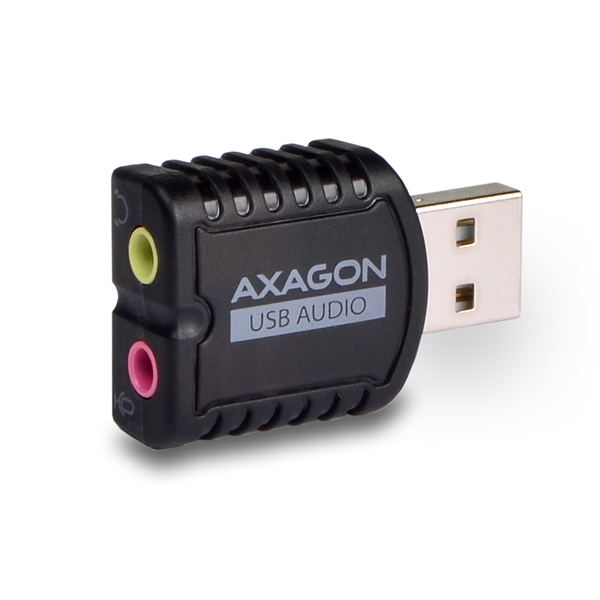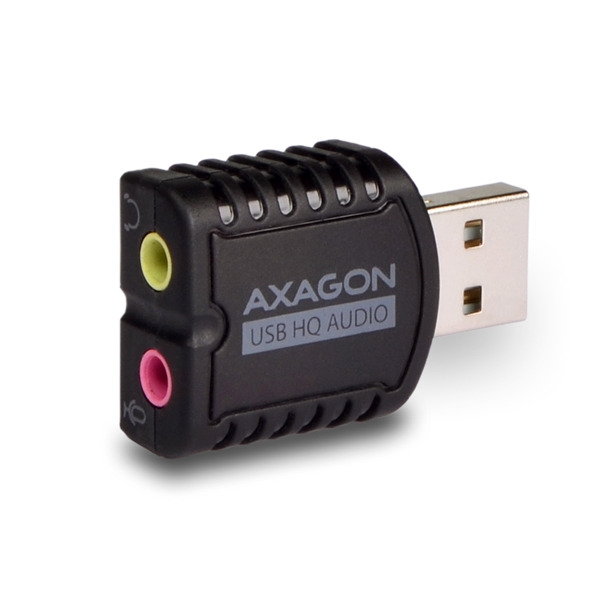ADA-HC USB-C - Hi-Res DAC audio adapter
Miniature USB-C audio adapter with 384 kHz / 32-bit DAC converter
| Input | USB-C male / on the cable, USB 2.0 |
| Output | stereo headphone output |
| PC connection | USB type C-M, cable 10 cm |
| design | miniature, metal casing |
| Extra | DAC CHIP |
Where to buy
The AXAGON ADA-HC Hi-Res DAC AUDIO ADAPTER is the ideal accessory for your phone, tablet, laptop or desktop computer with a USB-C connector, providing you with the missing 3.5 mm audio jack. The adapter contains a high-quality DAC converter that offers up to 384 kHz / 32-bit sampling during playback, which ensures excellent sound quality.
This audio adapter is optimal for lossless formats like FLAC, WMA, WAV, APE, AAC or ALAC in Apple Music, etc. Listening to music in the highest possible quality is available through premium accounts of platforms such as Spotify, Apple Music, YouTube Music and Amazon Music Unlimited. In addition, you can use this audio adapter for undisturbed viewing of other popular streaming services such as Netflix, Disney+, HBO Max, Amazon Prime or Apple TV+.
This adapter is the optimal choice for mobile phones and tablets that are no longer equipped with a headphone jack and only have a USB-C port. Such devices include products from Samsung, Apple (iPhone 15 and later / iPad), Xiaomi, Honor and Huawei.
Thanks to the DAC converter, with the ADA-HC you can enjoy music in higher quality than using the standard headphone output of your laptop. It will also serve well as a replacement for the non-functioning original sound card in the laptop, thus replacing the headphone output or microphone input. An advantage is also the ability to connect a microphone or headset for communication services WhatsApp, Messenger, FaceTime, Skype, Zoom, MS Teams, Google Meet, Discord, and the like. You can also use it to connect your mobile device to the AUX output in your car.
A stereo 4-pole TRRS connector with automatic CTIA or OMTP standard detection is used to connect headphones. The strength of the 10 cm long cable is ensured by high-quality nylon braiding.
Input:
• 1x USB 480Mbps male connector (USB 2.0)
• connecting USB connector type C male
Audio output:
• 2-channel analog 32-bit output (3.5 mm TRRS stereo jack)
• stereo output for headphones or active speakers
Audio input:
• 2-channel analog 16-bit input (3.5 mm stereo jack)
• stereo microphone input and input for recording analog signal
Sampling rate, resolution and output converter (DAC) noise:
• analog - 44.1 - 384 kHz @ 16 / 24 / 32bit (PCM) for playback
• Signal-to-Noise ratio (Output SNR) ≥ 124 dBA 32 ohm, 30 mW reference signal, 20 Hz - 20 kHz)
• Harmonic distortion (Output THD + N) ≤ -95dB (32 ohm, 20 mW, 20 Hz - 20 kHz)
Sampling rate, resolution and input converter (ADC) noise:
• analog - 48 kHz @ 16 bit (PCM) for recording
• signal-to-Noise ratio (Input SNR) ≥ 99dB (0 dB gain, Vref = 0.5 Vrms, 20 Hz - 20 kHz)
• Harmonic distortion (Input THD + N) ≤ -90 dB (0 dB gain, Vref = 0.5 Vrms, 20 Hz - 20 kHz)
Other features:
• Built-in 30mW @ R=32 ohm headphones amplifier.
• Impedance range of connected headphones 16 - 200 ohm.
• Frequency range 20 Hz - 20 kHz.
• USB 480Mbps interface (USB 2.0, backward compatible with USB 1.1).
• Easy to install thanks to full Plug and Play support.
• Possibility to connect your device while running thanks to the Hot Plug support.
• 3.5 mm jack, TRS, TRRS (CTIA & OMTP autodetection) compatible.
• Compliant with the USB Audio Device Class specification v1.0.
• Adapter power supply via USB (bus power) - no auxiliary power supply required.
• Miniature dimensions 25 x 7 mm, cable length 10 cm.
• Weight only 4 g.
Setting up a sound card in Windows allows:
• adjusting volume and balance of speakers
• settings for listening to the microphone
• extended speaker features: virtual surround sound, Dolby Atmos support
• Setting the sampling rate and bit depth for reproduction
Audio adapter settings in Android allow:
• adjusting volume and balance of speakers
• extended speaker features: virtual surround sound, Dolby Atmos support
• immersive sound
Audio adapter settings in iOS / iPadOS allow:
• volume setting
• hearing protection
• optimization for balanced sound
Supported operating systems:
• Windows 10 / 11 and later, macOS, iPadOS, iOS, Linux, Chrome OS and Android
Package contains:
• USB-C audio adapter
• packed in a sealed foil package with a hole for hanging
| Input | |
| interface | USB 2.0 |
| connector | USB Type C male on the cable |
| cable | 10 cm, permanently connected |
| Audio outputs | |
| analog output | 2-channel stereo output for headphones or active speakers |
| sampling rate | 44.1 / 384 kHz analog |
| resolution | 16 / 24 / 32 bit (PCM) for playback |
| signal-to-noise ratio | ≥ 124 dB (Output SNR) pro DAC |
| harmonic distortion | ≤ -95 dB (Output THD+N) |
| connector | 3.5 mm TRRS stereo jack |
| Audio inputs | |
| analog input | 2-channel stereo microphone input |
| sampling rate | 44.1 / 48 kHz analog |
| resolution | 16 bit for recording |
| signal-to-noise ratio | ≥ 99 dB (Input SNR) pro ADC |
| harmonic distortion | ≤ -90dB (Input THD+N) |
| connector | 3.5 mm stereo jack |
| Supported features | |
| automatic installation | yes |
| Plug and Play | yes |
| Hot Plug | yes |
| Other features | |
| dimensions | 25 x 7 mm |
| weight | 4 g |
| Power supply | |
| on the bus | yes (USB bus power) |
| OS support | |
| MS Windows | 10 / 11 and higher |
| MS Windows Server | yes |
| Mac OS | yes |
| Linux | yes |
PRODUCT PACKAGE
- packed in a sealed foil package with a hole for hanging
- package dimensions 204 x 143 x 8 mm
- weight of 1 pc package 10 g
- EAN 8595247908193
EXPORT PACKAGE
- number of pieces in the box: 500
- total weight of the box: 5.55 kg G.W.
- box dimensions: 20 x 31 x 46 cm
FAQ
A): The basic drivers are already part of the operating system.
B): When you connect the USB sound card to your computer, the necessary drivers are automatically detected and installed.
A): If the USB sound card is not displayed in "Device Manager", there may be a USB port malfunction.
B): Try plugging the sound card into another USB port. The sound card should be detected and the drivers loaded automatically. If the problem persists, plug the sound card into the USB port of another computer to verify its functionality.
A): You probably have enabled the “Listen to this device" option in the sound properties of the microphone.
B): To disable this option, go to http://www.axagon.eu/en/novinky/novinky/easy-help-with-fixing-a-microphone-echo.
A): The USB sound card cannot be used without a computer, e.g. by plugging into a TV.
B): The USB sound card uses the computer, its operating system and drivers for its operation. So it cannot operate without a PC.
A): The sound interference is probably caused by a wireless mouse transmitter.
B): We recommend that you place the mouse transmitter as far as possible from the sound card (preferably on the opposite side of the computer - the transmitter to the USB on the front PC panel and the sound card to the USB on the back of the PC - use a USB extension cable if necessary). If it is a laptop, then one device on each side.
A): The problem could be a lack of resources, check (when a problem occurs) the processor load and operating memory filling in "Task Manager".
B): If the CPU usage is 100% or memory is full, you need to find out what causes this situation. Another option is to connect a sound card to another computer to verify that the sound card is not damaged.
A): On most Axagon USB sound cards, the line input is merged into the microphone input.
B): The sound card has the ability to recognize whether a microphone or stronger "link" signal is connected. So, for example, when recording from the headphones output of a mobile phone, you need to reduce the volume on the phone to 80-90 % or reduce the signal intensity in the recording software so that the signal is not overexcited. In the recording software (such as Audacity), you need to set up the Microphone-USB as the signal source.
A): The USB sound cards generally have a higher latency (delay).
B): The solution is to use the ASIO4ALL drivers (http://www.asio4all.com/). ASIO are special sound drivers designed to achieve the smallest latency.
A): Yes, for example, the ADA-17 sound card can be used for Raspberry Pi.
B): The installation can be handled even by a layman, only plug the sound card into the USB port of the computer and the rest is done automatically.
A): You probably have allowed to listen to the microphone in Microphone Properties.
B): To disable this feature, follow these steps: Start -> Control Panels -> Hardware and Sound -> Sound -> Recording -> Microphone (USB Sound Device) -> Properties -> Listen -> Listen to this device - uncheck this box and confirm with "Apply".
A): Yes, you can set up two different tracks playing back simultaneously on one computer.
B): This is primarily a software issue requiring a player that supports sound redirection to a different sound card output than is set as "default" in the OS. Such functionality is supported, for example, by the VLC media player.











 ADA-10
ADA-10
 ADA-12
ADA-12
 ADA-17
ADA-17

